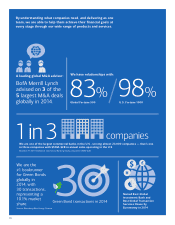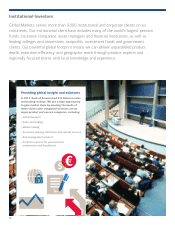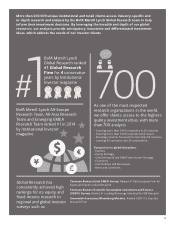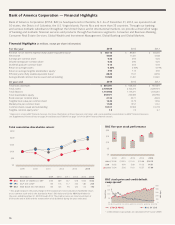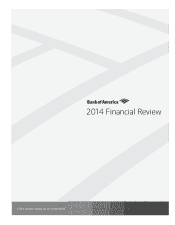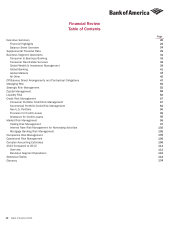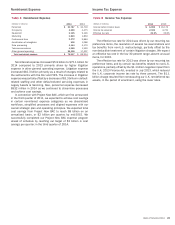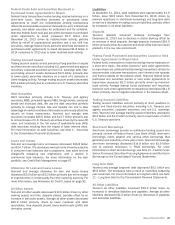Bank of America 2014 Annual Report Download - page 22
Download and view the complete annual report
Please find page 22 of the 2014 Bank of America annual report below. You can navigate through the pages in the report by either clicking on the pages listed below, or by using the keyword search tool below to find specific information within the annual report.20 Bank of America 2014
Executive Summary
Business Overview
The Corporation is a Delaware corporation, a bank holding company
(BHC) and a financial holding company. When used in this report,
“the Corporation” may refer to Bank of America Corporation
individually, Bank of America Corporation and its subsidiaries, or
certain of Bank of America Corporation’s subsidiaries or affiliates.
Our principal executive offices are located in Charlotte, North
Carolina. Through our banking and various nonbank subsidiaries
throughout the U.S. and in international markets, we provide a
diversified range of banking and nonbank financial services and
products through five business segments: Consumer & Business
Banking (CBB), Consumer Real Estate Services (CRES), Global
Wealth & Investment Management (GWIM), Global Banking and
Global Markets, with the remaining operations recorded in All Other.
Effective January 1, 2015, to align the segments with how we
manage the businesses in 2015, we changed our basis of segment
presentation as follows: the Home Loans subsegment within CRES
was moved to CBB, and Legacy Assets & Servicing became a
separate segment. Also, a portion of the Business Banking
business, based on the size of the client relationship, was moved
from CBB to Global Banking. Prior periods will be restated to
conform to the new segment alignment. Prior to October 1, 2014,
we operated our banking activities primarily under two charters:
Bank of America, National Association (Bank of America, N.A. or
BANA) and, to a lesser extent, FIA Card Services, National
Association (FIA Card Services, N.A. or FIA). On October 1, 2014,
FIA was merged into BANA. At December 31, 2014, the Corporation
had approximately $2.1 trillion in assets and approximately
224,000 full-time equivalent employees.
As of December 31, 2014, we operated in all 50 states, the
District of Columbia, the U.S. Virgin Islands, Puerto Rico and more
than 35 countries. Our retail banking footprint covers
approximately 80 percent of the U.S. population and we serve
approximately 48 million consumer and small business
relationships with approximately 4,800 banking centers, 15,800
ATMs, nationwide call centers, and leading online and mobile
banking platforms (www.bankofamerica.com). We offer industry-
leading support to approximately three million small business
owners. Our industry leading wealth management and trust
businesses, with client balances of $2.5 trillion, provide tailored
solutions to meet client needs through a full set of brokerage,
banking, trust and retirement products. We are a global leader in
corporate and investment banking and trading across a broad
range of asset classes serving corporations, governments,
institutions and individuals around the world.
2014 Economic and Business Environment
In the U.S., economic growth continued in 2014, ending the year
in the midst of its sixth consecutive year of recovery. After a
tentative and generally soft trajectory for five years where
annualized GDP growth averaged 2.3 percent, there were clear
signs of accelerated growth in the final three quarters of 2014
following a first quarter impacted by adverse weather conditions.
Employment gains picked up during the year, and the
unemployment rate fell to 5.6 percent at year end. Consumption
grew slowly early in the year, before picking up steadily and ending
with a robust pace in the final quarter. Core inflation remained
relatively unchanged in 2014, rising modestly in the first half and
falling thereafter, and ended the year more than half a percentage
point below the Board of Governors of the Federal Reserve
System’s (Federal Reserve) longer-term annual target of two
percent.
U.S. household net worth continued to rise in 2014 but at a
substantially slower pace than 2013. Home price appreciation was
less in 2014 than 2013 but prices still rose approximately five
percent in 2014 while equity markets gained approximately 11
percent. However, consumer spending was more significantly
enhanced by sharply lower oil prices late in the year, reflecting
foreign economic weakness amid an ample and growing energy
supply.
U.S. Treasury yields fell over the course of the year, reversing
much of the previous year’s increase. Declining world inflation and
interest rates helped push U.S. Treasury yields lower even as the
Federal Reserve steadily reduced and finally ended its purchases
of agency mortgage-backed securities (MBS) and long-term U.S.
Treasury securities. The Federal Reserve ended the year amid
indications that it can be patient with regard to normalizing
monetary policy.
Internationally, the eurozone grew modestly for much of the
year, with growth restrained by continued deleveraging of the
financial sector, high unemployment and political uncertainty.
Inflation in the eurozone also fell significantly to near zero by year
end. European bond yields continued to decline, especially as the
European Central Bank eased monetary policy and expectations
grew late in the year for outright purchases of sovereign and/or
corporate securities in 2015, and were subsequently confirmed
to begin in March 2015. The Euro/U.S. Dollar exchange rate also
fell significantly, boosting European competitiveness, particularly
in the second half of 2014, in direct reaction to the differing
directions of U.S. and eurozone monetary policies. Contentious
negotiations between parties to Greek sovereign and bank support
programs added to uncertainty and market volatility in the first
quarter of 2015.
In Russia, the combination of the U.S. and European Union
sanctions and sharply lower oil prices weakened growth. Select
emerging nations that are net energy suppliers also saw growth
diminish sharply, although other nations, including some emerging
economies in Asia received some benefits from declining energy
prices.
Following a quarter of strong economic growth ahead of a
consumption tax increase, Japan contracted through the middle
of the year and the Bank of Japan responded with stepped up
quantitative easing. Amid gradual economic moderation, China
also eased monetary policy late in the year.


